| Greece |
| GREECE | Picture Description |
|---|---|
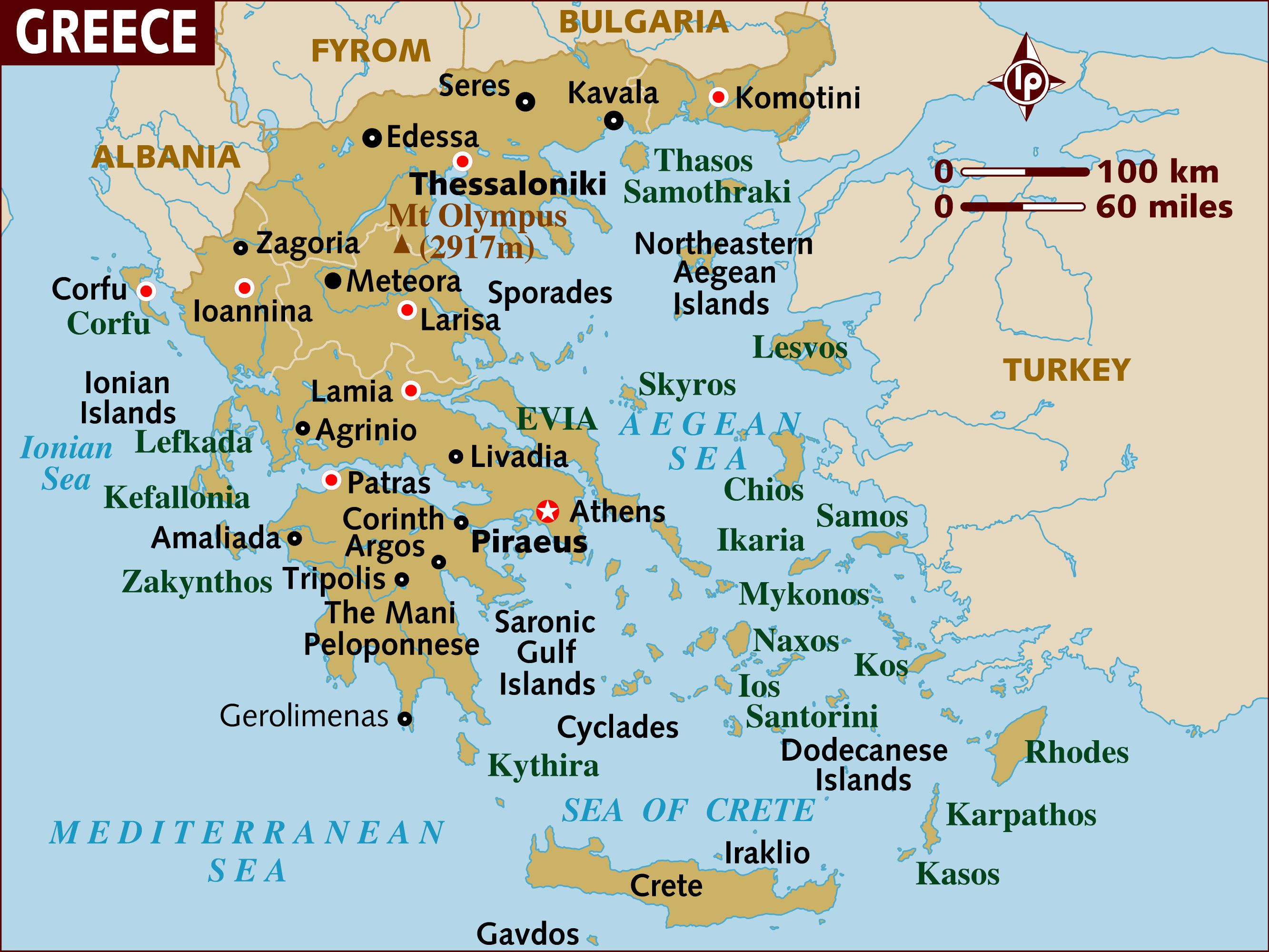
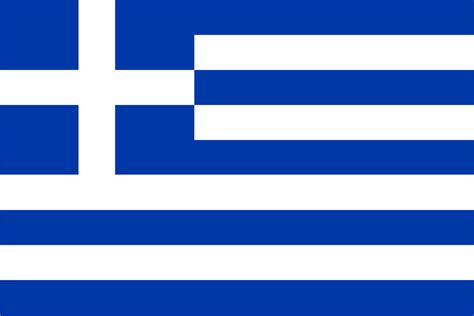
|
Greece Map & Flag of Greece Population : 10,497,595 (2023) Median age: 46.2 years Fertility rate: 1.4 children/woman(2023) Currency: Euro Real GDP PPP: $314.427 billion (2021) Real GDP per capita: $29,500 (2021) Population below poverty line: 17.9% Labor force - by occupation: Agriculture 4.1%, Industry 16.9%, Services 79.1% Source : Cia World Factbook Greece achieved independence from the Ottoman Empire in 1830. It gradually added neighboring islands and territories, most with Greek-speaking populations. In World War II, Greece was first invaded by Italy (1940) and subsequently occupied by Germany (1941-44); fighting endured in a protracted civil war between supporters of the king and other anti-communist and communist rebels. Following the latter's defeat in 1949, Greece joined NATO in 1952. In 1967, a group of military officers seized power, establishing a military dictatorship that suspended many political liberties and forced the king to flee the country. In 1974 democratic elections and a parliamentary republic abolished the monarchy. In 1981, Greece joined the EC (now the EU); it became the 12th member of the European Economic and Monetary Union in 2001. From 2009 until 2019, Greece suffered a severe economic crisis, due to nearly a decade of chronic overspending and structural rigidities. Beginning in 2010, Greece entered three bailout agreements with the European Commission, the European Central Bank, the IMF; and the European Stability Mechanism. |
| Athens Greece Feb 2024 | |

|
Athens, Greece PARTHENON The Parthenon is a temple dedicated to the goddess Athena in the fifth century BC. Its decorative sculptures are the high points of classical Greek art and an enduring symbol of Ancient Greece, democracy, and Western civilization. The Parthenon replaced an older temple of Athena that was demolished in the Persian invasion of 480 BC. The Parthenon was built to commemorate the Hellenic victory over Persian Empire invaders during the Greco-Persian Wars. The Parthenon also served as the city treasury. Construction started in 447 BC. It was completed in 438 BC. It was the treasury of the Delian League (the Athenian Empire). The Parthenon was converted into a Christian church dedicated to the Virgin Mary. After the Ottoman conquest in the 15th century, it became a mosque. In 1687 in the Morean War, a Venetian bomb landed on the Parthenon, which the Ottomans used as a munitions dump severely damaging the Parthenon. Since 1975, numerous large-scale restoration projects have been undertaken to preserve remaining artifacts and ensure its structural integrity. |
|
|
Athens, Greece TEMPLE OF ATHENA NIKE The Temple of Athena Nike is dedicated to the goddesses Athena and Nike. Built around 420 BC, the temple is the earliest fully Ionic temple on the Acropolis. It has a prominent position on a steep bastion on the corner of the Acropolis entrance, the Propylaea. In contrast to the Acropolis proper, a walled sanctuary entered through the Propylaea, the Victory Sanctuary was open, entered from the Propylaea's southwest wing and from a narrow stair on the north. The sheer walls of its bastion were protected on the north, west, and south by the Nike Parapet, named for its frieze of Nikai celebrating victory and sacrificing to their patroness, Athena and Nike. Nike was the goddess of victory in Greek mythology, and Athena was worshipped in this form, representative of being victorious in war. The citizens worshipped the goddesses in hopes of a successful outcome in the long Peloponnesian War fought against the Spartans and allies. |
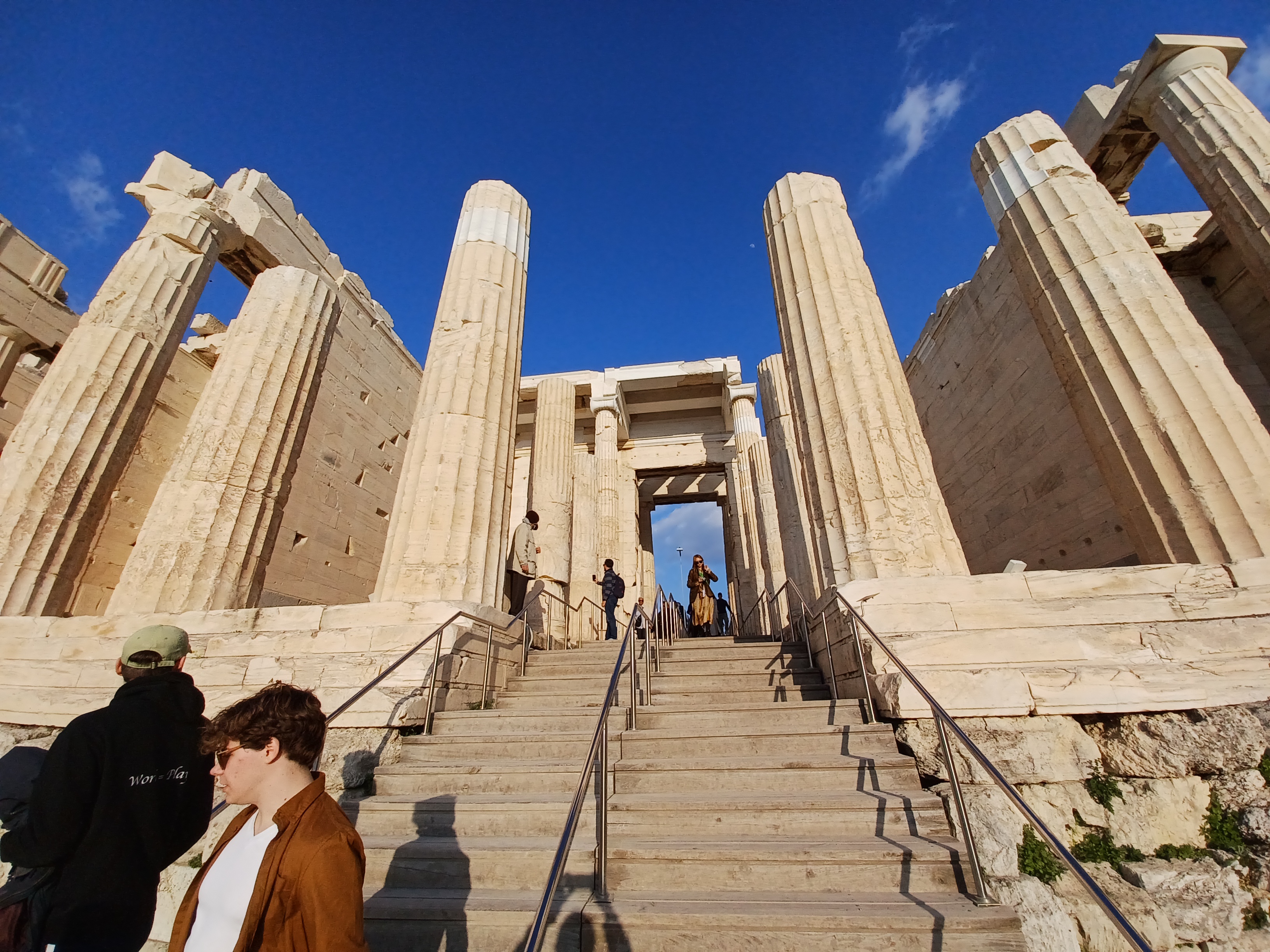
|
Athens, Greece PROPYLAIA The Propylaia served as the monumental ceremonial gateway to the Acropolis of Athens. This classical Greek Doric building was built between 437 and 432 BCE as a part of the Periklean Building Program. Its architect was Mnesikles. The Propylaia's post-classical history sees it return to a military function beginning with the construction of the Beule Gate in the late third century CE. |
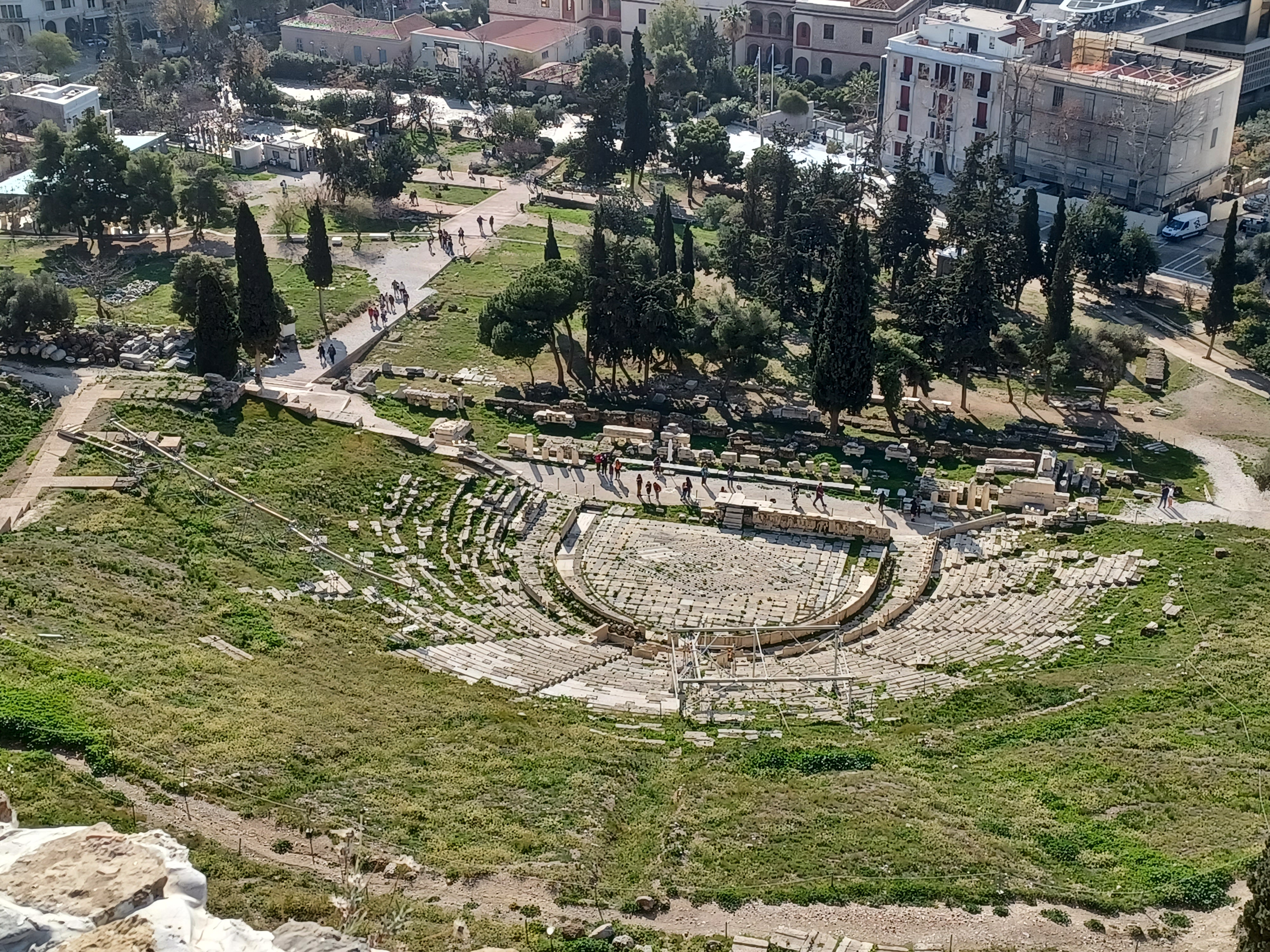
|
Athens, Greece THEATER OF DIONYSUS The Theater of Dionysus is an ancient Greek theatre in Athens. It is built on the south slope of the Acropolis hill, originally part of the sanctuary of Dionysus Eleuthereus (Dionysus the Liberator). It was constructed around the mid- to late-sixth century BC. The theatre reached its fullest extent in the fourth century BC under the epistates of Lycurgus when it would have had a capacity of up to 25,000. It was in continuous use until the Roman period. The theatre fell into decay in the Byzantine era and was not identified, excavated, and restored to its current condition until the nineteenth century. |
|
|
Athens, Greece OLD TEMPLE OF ATHENA The Old Temple of Athena or the Archaios Neos was an archaic Greek limestone Doric temple on the Acropolis of Athens probably built in the second half of the sixth-century BCE, and which housed the xoanon (cult image) of Athena Polias. The existence of an archaic temple to Athena had long been conjectured from literary references. In 1886, the discovery of building foundations between the Erechtheion and Parthenon confirmed it. The Old Temple of Athena stood on the central acropolis terrace in the late archaic period and was burnt down in the Persian invasion of 480. The nature, name, reconstruction remain unresolved mysteries. |
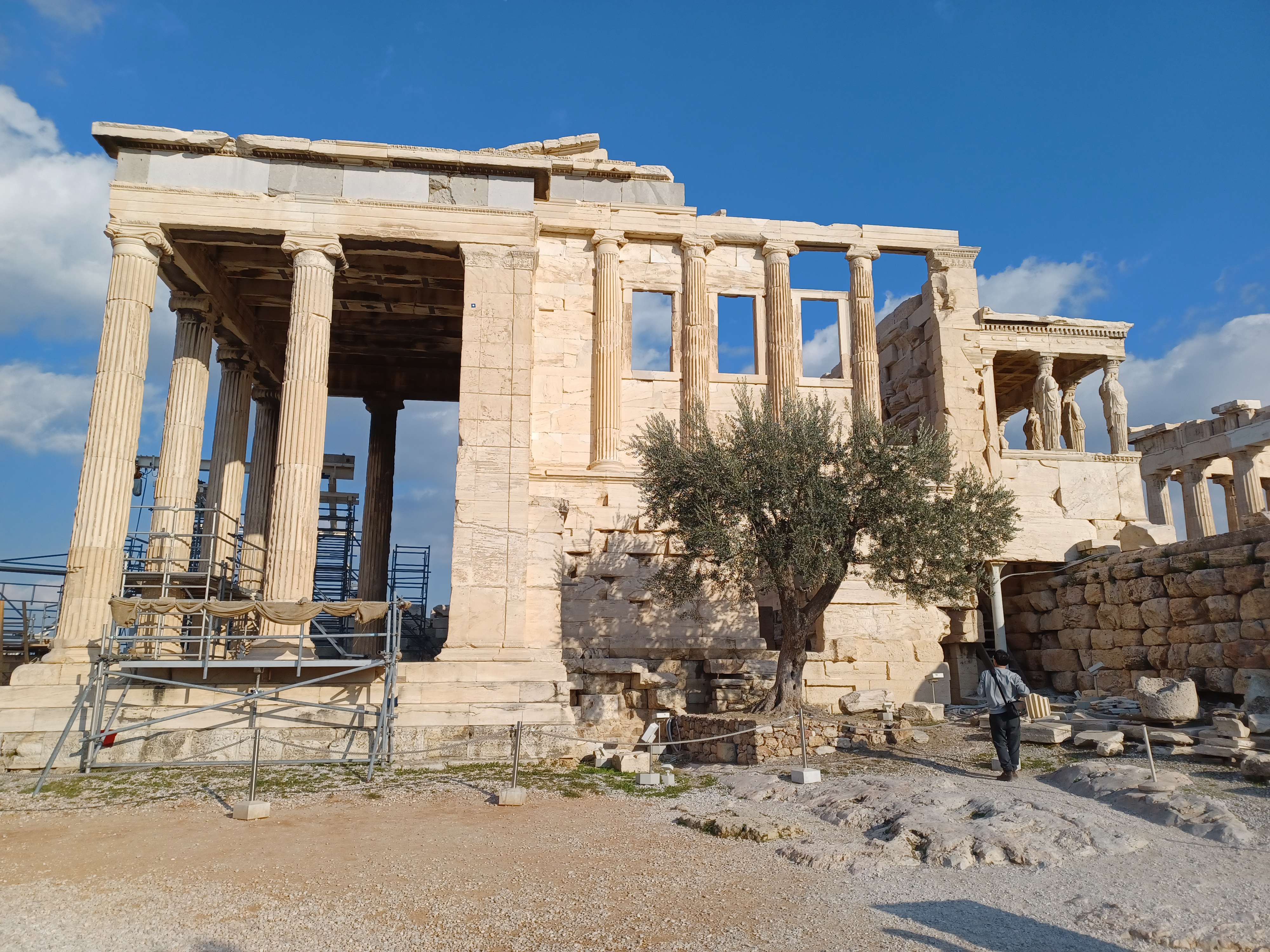
|
Athens, Greece PANDROSEION The Pandroseion is a sanctuary dedicated to Pandrosos who was one of three daughters of the first king of Athens, Kekrops. Pandrosos was the first priestess of Athena Polias the patron goddess of the Athens. In mythology, Kekrops had the head and torso of a man and the lower body of a snake. He judged the contest between Poseidon and Athena that decided the naming and patronage of the city. The Pandroseion is on the spot where Athena and Poseidon competed for the patronage of the city. The sacred olive tree which sprung when Athena struck the rock with her spear, giving her the victory. The salty spring which appeared when Poseidon struck with his trident and the tomb of king Kekrops who was the judge of the context. The sanctuary remains indicate it was open-air of trapezoidal design with a stroa of the Ionic Order. In 431 BCE the Erechtheion was attached to the Pandroseion. It was also integrated under the porch of the Caryatids. The Olive tree in the sanctuary today was planted in the 20th century in memory of Athena's sacred tree. |
|
|
Athens, Greece ERECHTHEION The Erechtheion is an Ionic order building named after the mythical king of Athens, Erechtheus. Construction started before the Peloponnesian War (431 BCE) and was finished in 406 BCE after the interruption of the works because of the war. The plan of the build is due to the irregularity of the ground and need to house ancient sacred spot of the salt spring which appeared when Poseidon struck the rock with his trident in a contest with Athena. It has a rectangular cella and an eastern section dedicated to Athena Polias. The western section was dedicated to the cult of Poseidon, Hephaistut and the hero Boutes. On the north side of the cell is a porch with 6 Ionic columns. The Porch of the Maidens (Korai) or Caryatids dominates the south side of the building, six statues of young women standing on a podium 5.8 feet (1.77 m) high. The frieze of Eleusinian stone with figures of Parian marble are now exhibited in the Acropolis Museum. |
|
|
Athens, Greece TEMPLE OF ROME AND AUGUSTUS East of the Parthenon lies the foundations of a small building attributed to the Temple of Rome and the Roman Emperor Octavian Augustus. The foundations has a dedicated inscription. The architectural members indicate that the Temple of Rome and Augustus was of the Ionic order, circular and monopteral. It had a single circular colonnade of nine columns (pteron) without a walled room inside (cella). Its diameter measured 28.2 feet (8.6 m) and its height was 23.9 feet (7.3 m) to the conical roof. The construction of the temple is associated with the architect who repaired the Erectheion in the Roman Period, because the architectural details of its members replicate those of the Erechtheion. It might have had statues of Rome and Augustus. It is the sole Roman temple on the Acropolis and the only Athenian temple dedicated to the Emperor. They created it to propitiate Octavian August. |
|
|
Athens, Greece ODEION OF HERODES ATTICUS The Odeion of Herodes Atticus was donated to the city of Athens by the famous orator, sophist and benefactor. It was used for musical events and philosophical lectures. Its semicircular cavea has a diameter of 249.3 feet (76m) and contained 39 rows of marble seats that could host 6,000 spectators. The marble paved orchestra is also semicircular and has a diameter of 62 feet (19m). The rectangular proskenion had a wooden floor 5 feet (1.5m) above the orchestra. It is 115 feet (35m) long and its façade projects 26 feet (8m) in front of the south wall of the concert hall. It has a stage of luxurious mosaic. Towards the proskenion, pilasters and columns framed the three doors of the stage and the doors of the side walls. The monument had a root of cedar wood. The Odeion was connected to the Stoa of Eumenes for the spectators of the theater of Dionysus. The Odeion was burned down by the Herulians in 267 CE. It was incorporated as a Roman fortification and remained in use until 1877. It survived demolition and stone pillaging so that its southern wall still stands to a height of 95 feet (29m). Archaeological excavations conducted by Kyriakos Pittakis freed the Odeion of medieval deposits and revealed its history. Reuse of the Odeion for musical events and theater performances started in the 1930s and became regular after 1957. |
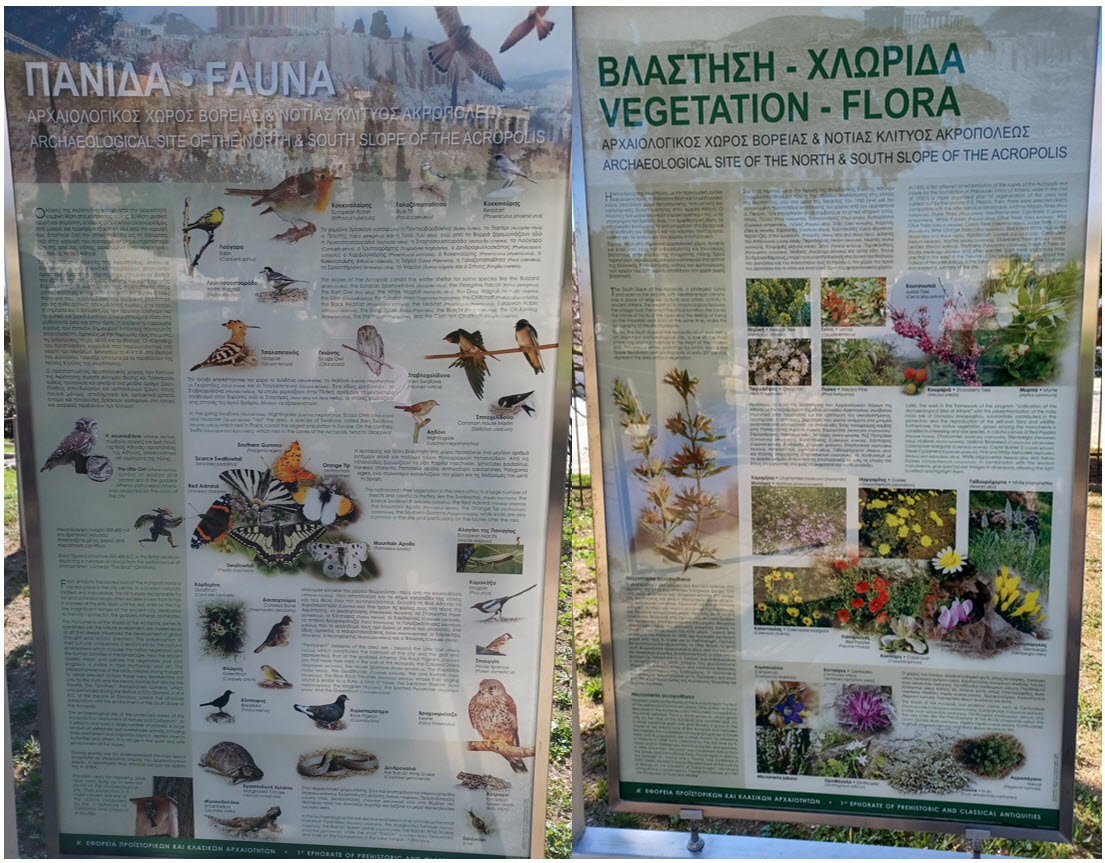
|
Athens, Greece FLORA & FAUNA OF THE ACROPOLIS Top Row: European Robin (Erithacus Rubecula), Blue Tit (Parus Caeruleus), Redstart (Phoenicurus Phoenicurus) Left: Siskin (Carduelis Spinus), White Wagtail (Motacilla Alba), Hoopoe (Upupa Epops) Middle: Scops Owl (Otus Scops), Barn Swallows (Hirundo Rustica), Nightingale (Luscinia Megarhynchos), House Martin (Delichon Urbicum) Right: European Mantis, Magpie, House Sparrow, Kestrel Butterflies: Scarce Swallowtail, Southern Gomma, Red Admiral, Orange Tip, Mountain Apollo Bottom: Goldfinch, Collared Dove, Greenfinch, Blackbird, Rock Pigeon, Marginated Tortoise, Small Stellion, Balcan Whip Snake, European Green Toads, Snail Flora: Medick Tree, Lentisk, Oleander, Aleppo Pine, Judas Tree, Strawberry Tree, Myrtle, Chamomiles, Mallows, Daisies, Calendulae Marigolds, Red Poppies, Caper Bush, Greek Cyclamens, White Mignonettes, Sternbergia, Campanula, Centaurea, Ornithogala, Harmal, Inula |
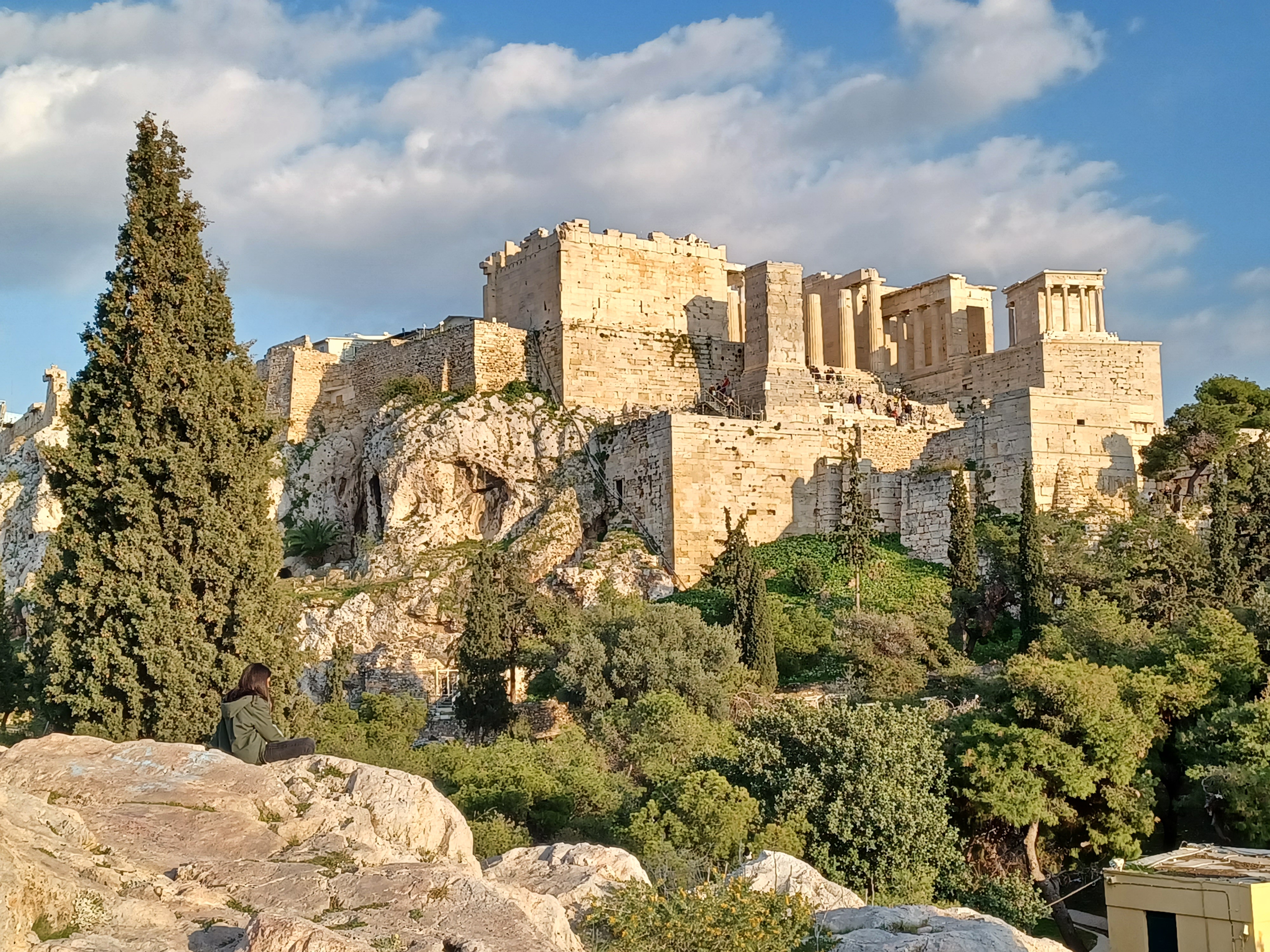
|
Athens, Greece AEROPAGUS HILL This is a view of the Acropolis from the nearby Aeropagus Hill. |
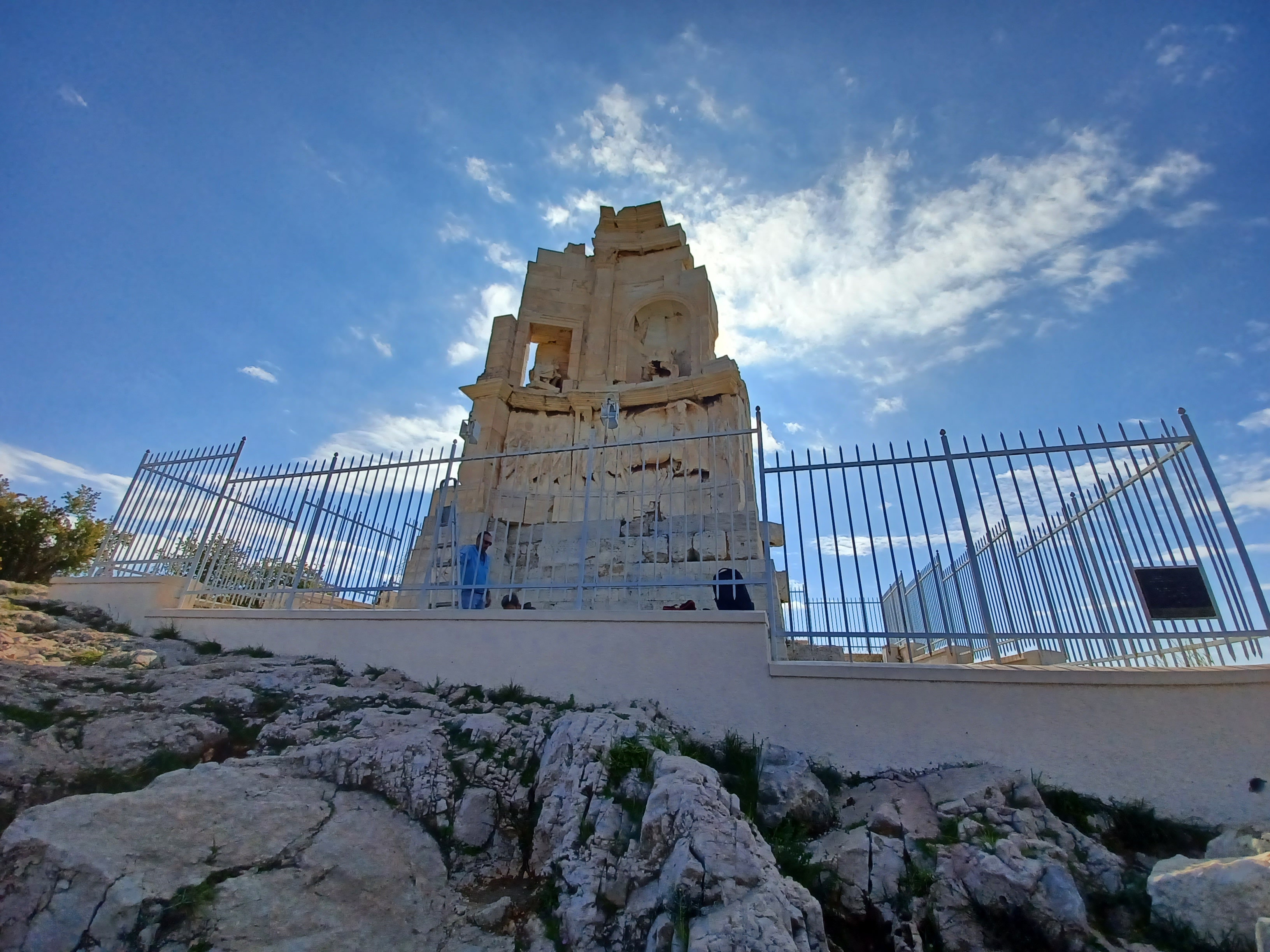
|
Athens, Greece THE HILL OF THE MUSES (PHILOPAPPUS) The highest of the three Hills west of the Acropolis took its name from the poet Mousaios, who lives, taught and was buried on it. It was thought the flat surface was the funeral monument of Mousaios. However, it is more likely a shrine to the Muses. The towering and commanding position of the Hill served as a stronghold of the Athenians against the Amazons and was later used as a strategically significant fortification in military operations. The Athenians of the 5th Century BCE included the Hill in the Themistoklean defense works. In 294 BCE Demetrios Poliorketes incorporated into the old walls a small fortress, known as the Macedonian Fortress and installed a garrison to control the city. In the 2nd Century CE Gaius Antichus Philopappus, prince of Kommangene in Upper Syria and benefactor of Athens, erected on the top of the Hill of the Muses his grade monument, 39.3 feet (12m) high, which from then on dominated the area and gave his name to the Hill. Built of pentelic marble on a porous-stone base it has a frize of Philopappos in a chariot with a retinue of rod-bearers and the upper has niches showing an enthroned Philopappos of Besa, sone of Epiphanes. |
|
|
Athens, Greece PLAKA The Plaka is the old historical neighborhood of Athens, clustered around the northern and eastern slopes of the Acropolis, and incorporating labyrinthine streets and neoclassical architecture. Plaka is built on top of the residential areas of the ancient town of Athens. It is known as the "Neighborhood of the Gods" due to its proximity to the Acropolis and its many archaeological sites. |
|
|
Athens, Greece PLAKA (Ionos Restaurant) There are many wonderful restaurants situated in the Plaka. We went to Ionos which had excellent service and served a variety of Greek dishes. |
|
|
Athens, Greece HADRIAN'S LIBRARY Hadrian's Library was created by Roman Emperor Hadrian in AD 132 on the north side of the Acropolis of Athens. The building followed a typical Roman forum architectural style, having only one entrance with a propylon of Corinthian order, a high surrounding wall with protruding niches at its long sides, an inner courtyard surrounded by columns and a decorative oblong pool in the middle. The library was on the eastern side where rolls of papyrus "books" were kept. Adjoining halls were used as reading rooms, and the corners served as lecture halls. The library was seriously damaged by the Herulian invasion of 267 and repaired by the prefect Herculius in AD 407-412. During Byzantine times, three churches were built at the site, the remains of which are preserved. another church, Agios Asomatos sta Skalia, was built against the north facade. A statue of the goddess Nike/Victoria was on the site. |
|
|
Athens, Greece PRISON OF SOCRATES The rooms cut into the rocky Hills west of the Acropolis (the Areopagus, Hills of the Nymphs and of the Mouses) is an open-air exhibition of the town planning and architecture of the ancients. It was carved into the rocky slops of the Hill of the Muses and served as a two or three-story dwelling. The wooden beams supported the front part of the structure which was made of stone masonry and wood.To the exterior floor were passageways connected with water channels cut into the façade of the building and a carved stairway at the south provided communication with the higher levels of the slope. The preserved back part of the structure is a complex of three rooms cut into the bedrock. The use of these cave-like rooms is unknown. Its proximity to the Athenia Agora must have led to the popular tradition that the building was the “Prison of Socrates” or an “ancient bath”. During World War II it was used to hid the antiquities of the Acropolis and sealed with a thick concrete wall. |
|
|
Athens, Greece ACROPOLIS FROM PHILOPAPPUS HILL This one of many breathtaking views of the Acropolis from Philopappus Hill. The Hill of the Muses also offers amazing views of the city of Athens and you can see the Aegean Sea from its vantage point. |
|
|
Athens, Greece Transportation We used a variety of Transportation options. We used a taxi from the Airport to our Hotel in the Athens city center. All the Taxis in Athens are colored yellow. We used Uber a number of times and also used public transportation the bus from the Marina. The buses were super-easy to use and had modern displays screens that would name off the stops the buses made as they come up to stops which helps greatly when you are trying to figure out when to hop off. We did not try the hop-on hop-off buses but people have said they are good. The tickets for buses also work with the Light rail systems. |
|
|
Athens, Greece PHILIPPOS UBER DRIVER One of my Uber Drivers, Philippos was really personable. I struck up a conversation and learned more about the locals. Philippos had been driving for Uber for 5 years with thousands of trips under his belt. I asked why all the Uber cars in Athens were yellow. He said he owned his car, and got about a 40% discount on it and that he had to buy it in yellow. He told me different areas in Greece had different designated Taxi/Uber colors. |
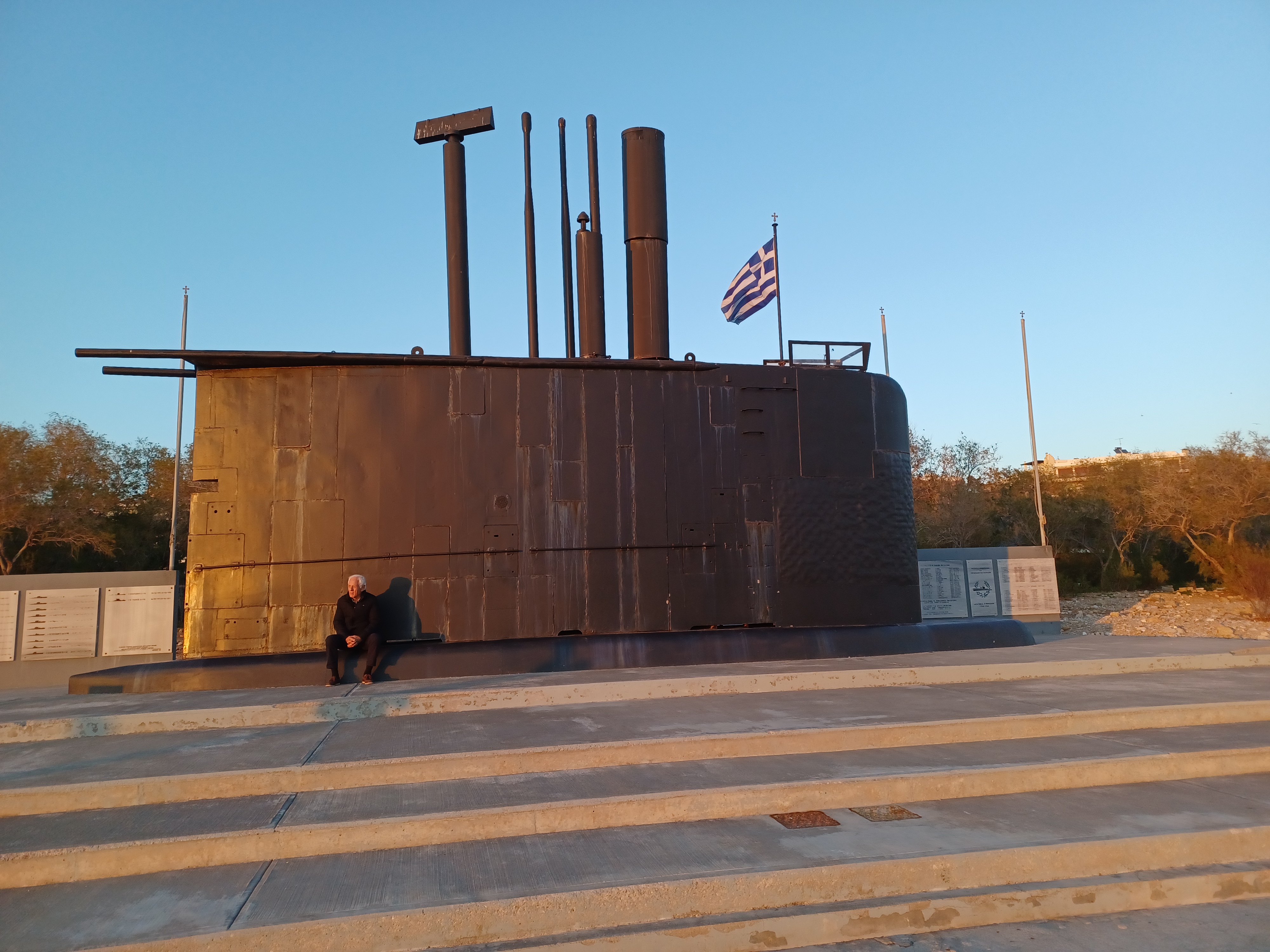
|
Athens, Greece FLISVOS PARK This was a World War II Submarine Memorial in Flisvos Park. Pesontes Upobruxion Eis Ton Bomon The Patridos |
|
|
Athens, Greece FLISVOS PARK There was a sea barrier wall along the south side of Flisvos Park. You could climb some stairs and walk along the interior lip of the wall. This was a fisherman who had just lifted up a lobster / crab cage from the sea using an grappling hook. |
|
|
Athens, Greece FLISVOS MARINA There were dozens of yachts moored at the Flisvos Marina. Pictured here is the Neraida. The Marina boardwalk had a variety of restaurants with outdoor seating. |
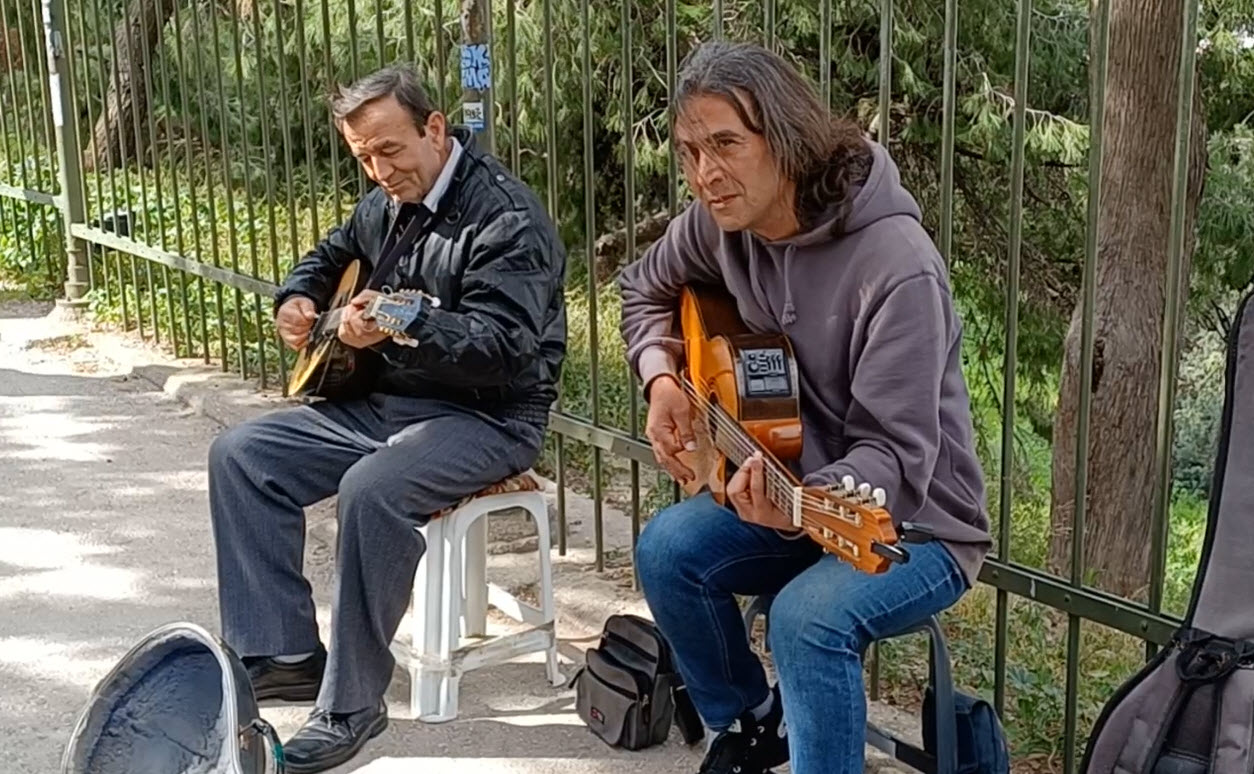
|
Athens, Greece LOCAL MUSICIANS Talented street musicians in Athens. They are playing classical Greek music. The Bouzouki sounds like a guitar but with a "tinnier" sound. The Lyre, Epigonion, Phorminx are other stringed Greek instruments with different tonal qualities. |
|
|
Athens, Greece NARANJ TREES Sour orange trees, also known as Naranj trees, offer a multitude of benefits and require proper care to thrive. These citrus trees were all over Athens and enhanced its aesthetics. One of our Uber drivers, Niko, told us that the Naranj tree had various uses ranging from culinary applications to natural remedies. Sugar can be added then boiled with water for 3 hours to make Marmalade which will keep for a year. The Bitter orange, sour orange, Seville orange, bigarade orange, or marmalade orange is in family of trees called Citrus aurantium. It is native to Southeast Asia and has been spread by humans to many parts of the world. It is probably a cross between the pomelo, Citrus maxima, and the mandarin orange, Citrus reticulata. |